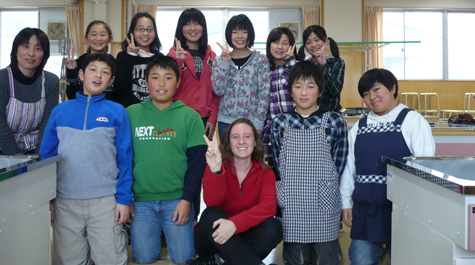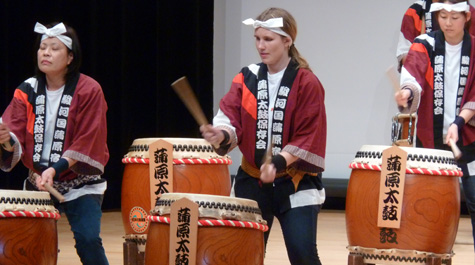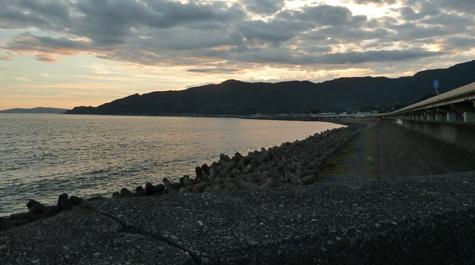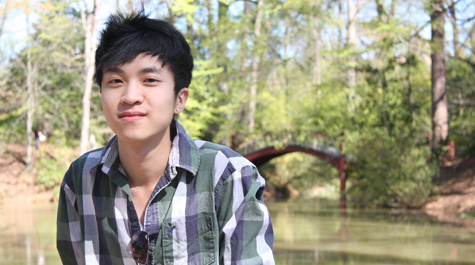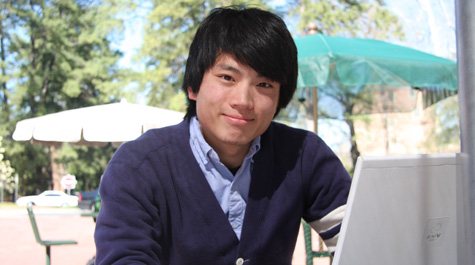Japan’s disaster affects W&M family
Alia Greenbaum ’07 had just finished teaching her sixth-grade class in the Miyagi Prefecture of Japan how to make French toast when the earth began to shake.
For Greenbaum, the earthquake felt like any other at first, but this time, the shaking didn’t stop.
“It was by no means my first earthquake, even a big one,” said Greenbaum, who has been working for the past four years as an Assistant Language Teacher (ALT) for the Japan Exchange and Teaching (JET) Programme. “So at first, I wasn’t worried about it, and almost laughed when the school nurse shoved me under my desk before taking cover herself. It was only when the shaking worsened and didn’t stop for what felt like hours that I worried.”
Greenbaum is one of many William & Mary alumni, students and faculty who were impacted by the magnitude-9.0 earthquake and subsequent tsunami that devastated Japan on March 11. Some, like Greenbaum, experienced the quake first-hand, while others felt the impact from afar — even on the College’s own campus — as they waited for news about friends and family halfway around the world.
Alumni in Japan
Being less than 50 miles away from the epicenter of the earthquake, the Miyagi Prefecture, along with three other prefectures, became ground zero for the worst natural disaster in Japanese history, which has claimed more than 18,000 lives. Fortunately, the town of Kami, where Greenbaum was living, was spared that day because it is far enough inland to escape the tsunami. But that did not mean that the town survived unscathed.
“We’re so close to the mountains, far from the ocean, that the tsunami didn’t reach us, for which I am very grateful,” said Greenbaum. “But we did lose power, which also meant no heat, and no hot water, and cell phone service was down.”
Greenbaum said the first night was the worst, as Japanese houses aren’t insulated. In the north, it got as cold as 21 degrees Fahrenheit.
The effects of the tsunami on nearby population center Sendai could also be felt in the days to come. As the tsunami destroyed one of the major gas refineries in the region and several of the roads leading to Kami, the township was also subjected to an extreme gas, and subsequently, food shortage.
“It got so bad that there were reports of looting, people stealing gas out of others’ cars,” Greenbaum said. “The other problem was the lack of contact with the outside world. There was no way to contact home, and we also had no way of getting any information.”
It wasn’t until three days later that Greenbaum heard about the situation at Fukushima Daiichi and Daini nuclear power stations. That was when she decided that it would be wise to leave the region, especially for the short term until the nuclear situation could be resolved.
Unlike Greenbaum, Megan Locke ’10, who holds an ALT position in Shizuoka Prefecture west of Greater Tokyo, had never experienced an earthquake before. Locke said that once the initial March 11 earthquakes hit -- a magnitude of about 4 since she was on the edge of the disaster zone -- the shaking wasn’t that bad. It was when the tsunami sirens in her town started going off that she began to get scared.
“Maybe 10 to 20 minutes after the shaking subsided, the tsunami sirens went off in my town. We are right next to the water, and the only thing separating my school from the beach is a giant tsunami barrier wall,” said Locke. “The next hour was definitely one of the scariest in my life. I didn’t want to believe the scenes of towns being submerged under water that we were watching on live TV might soon be my own town.”
The tsunami sirens never completely shut off that night. Locke said that they would go off periodically every hour or so and the fear of getting caught up in the sea was enough to keep everyone’s senses heightened.
“Waiting in the school, praying the tsunami wouldn't be as high as the barrier was a little like being holed up in a castle, hoping the enemy doesn't manage to breach the surrounding castle walls,” said Locke, “I don’t think any of us near the coast slept well that night, fearing that when we woke up, it would be too late to escape a tsunami during the night.”
Even though her area remained unharmed, Locke said that tensions have definitely risen throughout the city. For years, the people of Japan had been preparing for the “Great Tokai Earthquake,” an 8.0 or higher magnitude earthquake that occurs every 100-150 years in southwest Japan. Thus, Locke said, the Japanese government had installed massive tsunami barriers in her town along with many other countermeasures.
“Before the March 11 quake, most people seemed to trust the walls would work, but now no one is sure,” Locke said. “My teachers were fairly calm on March 11, but I think another big quake will immediately send us all running for the mountains right behind our town. The images of death and suffering up north seem like a chilling cautionary tale.”
Campus life impacted
Though the disaster occurred halfway around the world, the events that followed could be felt at William & Mary in the minds of students, faculty and staff -- especially among those who have relatives and friends in the affected regions.
Yoshiaki Nagata, an exchange student at William & Mary from Ohira Village in Miyagi Prefecture, first heard about disasters in Japan while traveling to England during spring break.
“At first, I thought it wasn’t that big of a deal,” said Nagata. “My friend posted something on Facebook and I thought ‘Tohoku has a lot of earthquakes.’ As the news got more and more major though, it hit me.”
Nagata, who is a student at Kanazawa University in Japan, said that reaching his family was hard at first, but once he did, he was very relieved. Ohira, being six miles south of Kami, was also able to avoid much of the damage from the tsunami.
For Nagata, not knowing scared him the most. Even now, he is still not able to get in contact with some friends in the region. In response, he has created a Facebook group called “Save Japan” in an effort to raise awareness.
“In my opinion, I strongly feel that we need to keep this action as long as possible,” he said. “A lot of news will disappear from the top headlines of our newspapers. Now, we have a special page for Japan, such as their nuclear problem. But I want the issue to be prevalent.”
For Steven Pau ’14, a peaceful spring break in Williamsburg was disrupted by a sudden text message in the night about the earthquake. When Pau, who has relatives in Japan, found out that the disaster zone spread across Sendai and neighboring Fukushima Prefecture, he was horrified.
“The day after the earthquake, I learned that five of my relatives living in Sendai and Fukushima were officially missing,” said Pau. “The disasters in Japan kept me up for nights, and, when I finally could sleep, I was tormented by nightmares.”
Of the five who were missing, two cousins around the same age as Pau died in the tsunami. The other three happened to be in Osaka and Tokyo at the time and were safe.
“While people were still having fun and enjoying the spring break without any knowledge of the disasters that just happened in Japan, I was figuring out what I could do,” Pau said. “I felt very hopeless for a long time, but I also decided that I did not want to tell many people about how the disasters affected me yet. As people started coming back to campus, I tried to hide a lot of the pain and sorrow I was feeling.”
Pau said that he eventually found solace in his desire to help Japan.
“Although it was very hard to cope and continue each day at school without breaking down, what kept me going was the motivation to help others from having to go through the same experience I did,” said Pau.
Currently, Pau is involved with several philanthropic initiatives including “Heal Japan,” a relief initiative started by two William & Mary alumni, and the “1,000 Cranes for $1,000” campaign run by the Japanese Cultural Association. He will also speak about his experiences during a candlelight vigil being held in front of the Wren Building at 8 p.m. on April 11, the one-month anniversary of the earthquake.
Recovering from a disaster
In times of disaster, Nagata said that the compassion of William & Mary students was what touched him the most.
“A lot of W&M students asked me after the disasters if I was okay, and it really lifted my spirits,” he said. “I think that me, as a person from the affected area, is a special case, but students’ kindness really helped me to overcome these difficulties.”
As for Greenbaum, what should have been a five-hour trip out of the region turned into a harrowing three-day ordeal. Eventually, she made it to Okinawa, where two fellow William & Mary alumni are currently residing and have stayed with them since.
Though she’s lived through emergency situations before, this one once again served to remind her about what’s important in disaster situations.
“It’s definitely an unsettling feeling,” Greenbaum said. “But it really drove home just how important people are. No matter what happens, as long as the people are safe, it’ll all be alright somehow.”















